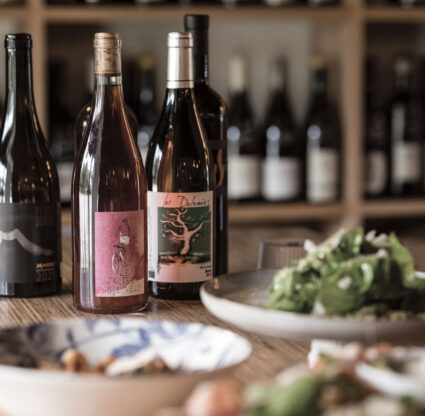Looks like the mayans were wrong. In a glass-is-half-empty sort of way, that leaves us with a lot of time to fill. And to help facilitate that, we’ve decided to offer this column, affectionately entitled Mr. Adventure. Each month, I, Mr. Adventure (see accompanying lovely illustration), will go out and experience something, you know, adventurous, that will leave you equal parts envious and itchy (that is to say you will scratch your head).
As you know, the definition of adventure is different for everyone (well, not for people with dictionaries, but whatever), and while things such as charging into the bush, ice climbing or running rapids in piranha-infested waters might mean adventure to some, this writer finds one of the most unexplored and strange places on the planet to be—wait for it—a kitchen. It may not seem dangerous or compelling to you, but if you’d gone your entire life without seeing a professional kitchen in action, I can promise you it’s like being in the engine room of an ocean-going ship—sans the chanteys.
And as you can see from the aforementioned beautiful illustration accompanying this column, I am a man unafraid to set things on fire. As Deepak Chopra once said, “Adventure brings equilibrium to the universe and the boys to the yard.” (I may have paraphrased that.) So, there I stood in the fully functional kitchen of Chef Fabrizio Aielli’s Sea Salt restaurant in Naples, awaiting my chance to help out—maybe I’d make some salads, boil some pasta, grill a fish, help a family come together over a plate of veal cheeks …
As suspected, a kitchen is a daunting space filled with fire and knives and a surprising amount of foreign vernacular. There’s a great deal of stress and people wanting you to do the dishes or taste something strange all while understanding that there is a table of four just yards away waiting for the very sustenance which gives them life. Basically, no pressure.
Luckily, Executive Chef Jason Goddard doesn’t seem to mind the heat. The charming 29-year-old foodie was nice enough to invite me into the kitchen to see just what goes into creating some of the finest food on the Gulf coast: the chopping, roasting, puréeing and deboning that apparently needs to be done before you can send out a check. This is a guy who used eyedroppers to drip a mixture of tomato juice and algae into a calcium bath to create faux caviar. The same guy who came up with saffron cappuccino sea urchin soup and says, “Try the nitrogen-poached beef tartar.”
His day starts at around 9:30 a.m. receiving shipments of fresh ingredients (veggies, fruits, meat, fish, etc.), which doesn’t sound so bad until you realize it continues right through to 11 p.m., six, sometimes seven, days a week. It seems the secret to being a successful executive chef is putting yourself in a position to control absolutely everything. When the purveyors of produce arrive in the morning, Goddard is there to decide whether or not everything is fresh and Sea Salt worthy. When the fish guy shows up, he better have brought fish that were still having thoughts on the way to the restaurant or they’re getting back on that truck. (Seriously, this guy is crazy about fresh fish: turbot, snapper, hogfish, grouper, branzino—you name it.)
And he likes to buy them whole. “The good thing about buying whole fish is that you can see it in their eyes,” he says. I looked, and must admit, that lying there, the snapper seemed especially flirtatious—a come-hither look from a bed of ice. It turns out that a lot of Sea Salt’s customers order their fish whole—head, eyes, tail, et al. (I’ve been told there’s a lot of meat in the head, but I’ll never know for sure.)
Nevertheless, when you’ve been granted access to a world-class kitchen, you want to take full advantage. But you must walk before you can run, says Goddard. So he brought me to the kitchen’s command center, where, between great slabs of marble and stainless steel you can see virtually everything that’s happening, to explain the activity that had already begun.
It seems that there are six stations in the kitchen, none of which I’m qualified to be in: the pantry station, salad station, pasta station, sauté station, fry station and grill station. Within them work the very focused Domingo, Jonathan, Graham and Tim dressed all in black (it’s slimming) and working on orders. There are five ticket printers throughout the kitchen so the various cooks and chefs know immediately what’s been ordered and where it’s going. Not that they’ll be taking that food out to the guests. That’s the food runner, Moreno’s, job. The cooks never seem to leave their five-square-foot area. “When a ticket gets printed, you have five minutes to get the first course to the table,” says Goddard, in a tone that made me think I was going to be personally responsible for the family at table 204. “By the time we see the ticket, they’re probably been here 15 to 20 minutes.”
I assure him I am already an expert food orderer; it’s the kitchen skills I’m lacking. Unfortunately, kitchens aren’t huge. I’m not sure how big I thought they were, but I thought there’d be enough room for me to attempt a baked Alaska while everyone else did their thing. (They don’t even serve baked Alaska, but I really do enjoy setting things on fire.) At the very least I want to chop things or cut things up. Where are the vegetables?
Microgreens? Goddard is big on them. Beet, kale, spinach, pea, mustard, red cabbage, daikon radish—the list is virtually endless. Basically, they’re seedlings less than 14 days old, which may or may not have been grown on Farmville. Chopping or cutting them is pointless and would require the use of an electron microscope.
In the meantime, things are picking up in the kitchen and I’m taking up valuable space. Goddard suggests my opportunity to shine might come a bit later in the culinary process; when the perfectly grilled whole branzino makes its way to the private chef ’s table, which I’ll occupy alone. Perhaps I could “debone.”
Deboning, as you might imagine, is the act of removing bones from a whole cooked fish. Under most circumstances, deboning is left to the waitstaff, but as I wasn’t able to really get knee-deep into sautéing or prepping or grilling or even dishwashing (Seriously? I’m not even qualified for that?), Goddard tells me to give it a go. “Some things aren’t for everybody,” he says. For the record, I deboned the hell out of that fish.





